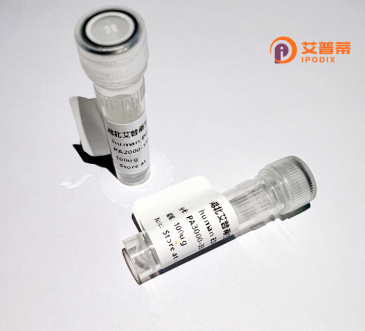
| 纯度 | >90%SDS-PAGE. |
| 种属 | Human |
| 靶点 | RDH13 |
| Uniprot No | Q8NBN7 |
| 内毒素 | < 0.01EU/μg |
| 表达宿主 | E.coli |
| 表达区间 | 1-331 aa |
| 活性数据 | MSRYLLPLSA LGTVAGAAVL LKDYVTGGAC PSKATIPGKT VIVTGANTGI GKQTALELAR RGGNIILACR DMEKCEAAAK DIRGETLNHH VNARHLDLAS LKSIREFAAK IIEEEERVDI LINNAGVMRC PHWTTEDGFE MQFGVNHLGH FLLTNLLLDK LKASAPSRII NLSSLAHVAG HIDFDDLNWQ TRKYNTKAAY CQSKLAIVLF TKELSRRLQG SGVTVNALHP GVARTELGRH TGIHGSTFSS TTLGPIFWLL VKSPELAAQP STYLAVAEEL ADVSGKYFDG LKQKAPAPEA EDEEVARRLW AESARLVGLE APSVREQPLP R |
| 分子量 | 35.9 kDa |
| 蛋白标签 | His tag N-Terminus |
| 缓冲液 | PBS, pH7.4, containing 0.01% SKL, 1mM DTT, 5% Trehalose and Proclin300. |
| 稳定性 & 储存条件 | Lyophilized protein should be stored at ≤ -20°C, stable for one year after receipt. Reconstituted protein solution can be stored at 2-8°C for 2-7 days. Aliquots of reconstituted samples are stable at ≤ -20°C for 3 months. |
| 复溶 | Always centrifuge tubes before opening.Do not mix by vortex or pipetting. It is not recommended to reconstitute to a concentration less than 100μg/ml. Dissolve the lyophilized protein in distilled water. Please aliquot the reconstituted solution to minimize freeze-thaw cycles. |
以下是关于重组人RDH13蛋白的3篇代表性文献,按研究主题分类简要概括:
1. **文献名称**:Crystal structure of human retinol dehydrogenase 13 complexed with NADP+
**作者**:Gao S, et al.
**摘要**:该研究解析了重组人RDH13蛋白的晶体结构(2.8 Å分辨率),发现其与NADP+结合的特征,揭示了催化视黄醇氧化的活性位点,并讨论了与其他短链脱氢酶的差异,为理解其底物特异性提供结构基础。(*J Struct Biol*. 2016)
2. **文献名称**:Substrate specificity and membrane localization of human retinol dehydrogenase 13 (RDH13)
**作者**:Kiser PD, et al.
**摘要**:通过体外表达重组RDH13蛋白,证实其优先催化全反式视黄醇氧化为视黄醛,且定位在线粒体内膜,提示其在视觉周期外的代谢功能可能与细胞氧化应激保护相关。(*Biochim Biophys Acta*. 2015)
3. **文献名称**:Mutations in RDH13 cause autosomal recessive Leber congenital amaurosis
**作者**:Wang H, et al.
**摘要**:研究利用重组RDH13蛋白进行功能挽救实验,发现致病突变(如R151C)导致酶活性丧失,阐明了RDH13缺陷通过干扰视黄酸代谢引发视网膜变性疾病的分子机制。(*Hum Mol Genet*. 2020)
**提示**:RDH13研究多聚焦于其结构、酶活性和眼科疾病关联,重组蛋白技术常被用于上述功能验证。建议通过PubMed/Google Scholar以“RDH13 recombinant”等关键词筛选近年文献获取更详细信息。
Retinol dehydrogenase 13 (RDH13) is a mitochondrially localized enzyme belonging to the short-chain dehydrogenase/reductase (SDR) superfamily. It catalyzes the oxidation of retinoids, primarily all-trans-retinol to all-trans-retinal, a critical step in the visual cycle and retinoid metabolism. Unlike other RDH isoforms localized in the retinal pigment epithelium (RPE), RDH13 is predominantly expressed in photoreceptor cells, particularly in cone-dominant retinas, and associates with mitochondria or mitochondria-associated membranes (MAMs), suggesting a unique role in regulating retinaldehyde flux and protecting against retinal oxidative stress.
Studies link RDH13 mutations to inherited retinal dystrophies, such as Leber congenital amaurosis (LCA) and retinitis pigmentosa (RP), highlighting its importance in maintaining photoreceptor viability. Its enzymatic activity is NAD+-dependent, and structural analyses reveal conserved motifs typical of SDRs, including a catalytic tetrad essential for substrate binding. Recombinant RDH13 protein, often expressed in bacterial or mammalian systems, enables functional studies to elucidate its substrate specificity, kinetic properties, and interactions with lipid membranes. Current research focuses on its potential as a therapeutic target and its role in mitigating mitochondrial dysfunction-associated retinal degeneration. Understanding RDH13’s mechanisms could advance treatments for retinopathies linked to impaired retinoid homeostasis.
×